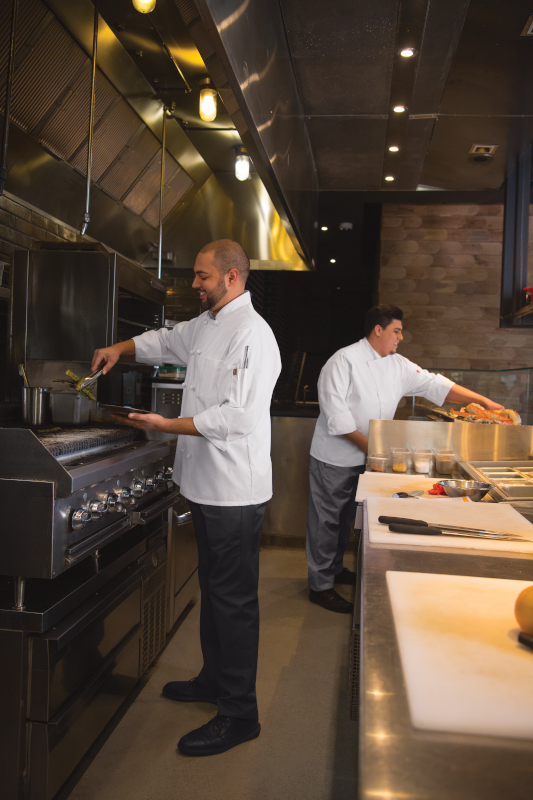
Chef uniforms are most commonly white, typically with a white chef’s jacket and hat. There is a long history behind why chefs most often wear white.
Do All Chefs Wear White?
No. While it’s most common for chefs to wear white, some chefs don’t wear white.
Lately it has become trendy for chefs to wear black or another color of their choice, often to align with the theme of a particular restaurant. Chefs also no longer wear the tall chef’s hats as often as they did in prior generations.
However, white is still the most popular color for chefs around the world. This tradition dates back 200 years.
The History of Chefs Wearing White
The history of chefs wearing white is believed to be attributed to French chef Marie-Antoine Carême, who sought to establish a sense of professionalism and respect for individuals working in the industry back in 1822. Prior to this time, chefs were not highly respected. They were often overlooked and performed their work behind the scenes in kitchens.
As cuisine became increasingly featured in popular media and chefs in France gained notoriety, Chef Carême saw the opportunity to create a uniform that would serve as a badge for the industry and trade.
The reason Chef Carême selected white is not entirely clear, but it is likely he wanted to demonstrate cleanliness and sterility in the kitchen, similar to nurses and doctors traditionally wearing white to reflect a clean and sterile environment. Chef Carême was also extremely aware of the way he looked to customers, and he felt that white demonstrated the height of professionalism for a chef.
Reasons Chefs Wear White
Chefs now wear white for a wide range of reasons. Some of the most common are:
History and tradition: Chefs wear white due to the history of the first chef’s uniform being white and the desire for chefs to honor this history and the tradition it created.
Availability: Additionally, because the first chef’s uniform was white and many chefs have followed this tradition, manufacturers produce far more white uniforms and jackets than any other color. Many chefs wear white simply because these uniforms are more widely available.
Demonstration of cleanliness: A white uniform makes spills and stains exceptionally noticeable. A chef whose uniform is free of such markings gives the impression of care, cleanliness and precision, creating confidence in the quality and cleanliness of their food.
Demonstration of professionalism: A uniform provokes a sense of professionalism in any field. Because a chef’s uniform is traditionally white, a chef who wears a white jacket or uniform will elicit a sense of professionalism and industry membership to customers, increasing their confidence in the chef’s qualifications and abilities.
Reflection of purity: The color white has historically been associated with qualities like peace, purity, cleanliness, sterility and freedom from blemish. These are all characteristics desirable in the restaurant industry. A chef who wears a clean, wrinkle-free, white uniform is likely to reflect these characteristics to customers in the same way that a doctor or nurse exhibits these traits to patients when they wear white uniforms.
Heat absorption: Though it was not Chef Carême’s original intent when he designed the first widely accepted chef’s uniform, advocates of the white chef’s uniform later recognized that white more effectively absorbed heat than other colors. Professional kitchens can be extremely hot environments, reaching temperatures of more than 100 degrees Fahrenheit in some cases. Keeping cool is important to prevent heat exhaustion and stay energized despite the long hours and demanding work environment of a restaurant.
Washability: Though this was also not the original intent of Chef Carême, chefs who wore white uniforms have noticed that uniforms of this color can be easily bleached. Stains and markings from food on these uniforms are not permanent and can be removed without having to replace the entire uniform.
Mitigation of cross contamination: Food spills and stains left on jackets can cause cross contamination or the transfer of harmful bacteria from foods to other foods or across areas of the kitchen. Such spills on white clothing are easily noticeable, helping the chef recognize when a quick change is needed.
Alsco Can Fulfill Your Uniform Needs
Find some of the highest-quality and most comfortable uniform options with Alsco. When you rent food service and restaurant uniforms you ensure your chefs are consistently outfitted in chef whites that look good and are free of tears, stains and other imperfections. Alsco can also handle your uniform laundering so you always have clean uniforms on hand.
References
Chef Uniforms. (2022). Alsco.
Why Do Chefs Wear White? (May 2016). Daily Meal.
Why Do Chefs Wear White? (August 2020). Glion University.
